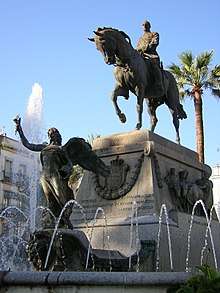Monument to Primo de Rivera (Jerez)
The monument to Primo de Rivera is an instance of public art in Jerez de la Frontera, Spain. It consists of a bronze equestrian statue of Miguel Primo de Rivera, on top of a sculptural ensemble placed inside a fountain. It lies at the centre of the Plaza del Arenal.
.jpg) | |
| Coordinates | 36.68153°N 6.137933°W |
|---|---|
| Location | Jerez de la Frontera, Spain |
| Designer | Mariano Benlliure |
| Material | Bronze, stone |
| Opening date | 29 September 1929 |
| Dedicated to | Miguel Primo de Rivera |
History and description
The monument was proposed in December 1923 by municipal councillor Antonio Montilla Rivero after the September 1923 coup d'etat, and the proposal was unanimously accepted.[1][2] The managing committee of the monument was appointed in 1925.[2] The monument was funded via popular subscription.[2] The design of the monument was awarded to Mariano Benlliure.[2]
Building works started on 2 October 1928.[2] Benlliure reportedly used a horse from the regiment of Hussars of La Princesa as model for the equine figure.[3] The front side of the pedestal features a coat of arms of Spain and an inscription reading: "al ilustre jerezano, restaurador del orden, miguel primo de Rivera y orbaneja, pacificador de marruecos y marqués de estella. la patria agradecida." ("to the illustrious jerezano, restorer of order, Miguel Primo de Rivera y Orbaneja, Peacemaker of Morocco and Marquis of Estella. The grateful homeland").[2]
A winged Victory emerges ahead of the front side of the pedestal, grabbing a laurel branch with her right hand and a Pickelhaube general's helmet with her left arm.[4][2] Both lateral sides of the pedestal feature sculptural compositions.[5] The right-hand one, with the "estudiando el definitivo plan de avance" inscription ("studying the ultimate breakthrough plan"), consists of a meeting of generals around Primo de Rivera, also attended by Sanjurjo, Despujols, Fernández Pérez, Saro and Admiral Guerra.[2] The left-hand side of the pedestal features an sculptural ensemble with five moors working the land with two oxen, reading "el punto de la victoria" ("the point of victory").[2]
The backside of the monument incorporates an allegory of Peace or Plentifulness, holding cereal spikes, with two cornucopias at her feet,[4] as well as a bronze relief consisting of an effigy of Miguel's brother Fernando—fallen in Monte Arruit in 1921—put inside a medallion bordered by laurel wreaths, with an inscription below reading "honrando a sus héroes" ("honoring its heroes").[6]
It was unveiled on 29 September 1929, during a ceremony attended by the dictator himself.[5]
Pigeons use to deposit their droppings mercilessly on the monument.[7]
.jpg) Lateral side, featuring the meeting of generals
Lateral side, featuring the meeting of generals Closer view of the monument featuring the winged victory
Closer view of the monument featuring the winged victory
References
- Citations
- "La historia olvidada del Arenal". Diario de Jerez. 12 March 2017.
- "Los grandiosos homenajes celerados en honor del Presidente y del Vicepresidente del Gobierno, en Jerez y Barcelona, respectivamente". La Nación. Madrid: 3. 30 September 1929. ISSN 1132-046X.
- Reyero 2013, p. 109.
- Sánchez Villanueva 2015, p. 237.
- "El escenario más jerezano al que llamaron Arenal". La Voz de Cádiz. 23 March 2008.
- Bravo Nieto 2013, p. 112.
- Romero Bejarano, Manuel (26 October 2008). "El ángel del monumento". Diario de Jerez.
- Bibliography
- Bravo Nieto, Antonio (2013). "1921. Los Cazadores de Alcántara y la memoria reflejada: un capítulo de la escultura pública y monumental española" (PDF). Que las cifras hablen. Historia de la laureada del Alcántara. Melilla: UNED. pp. 101–128. ISBN 978-84-937147-4-1.
- Reyero, Carlos (2013). "Benlliure monumental". Mariano Benlliure. El dominio de la materia (PDF). pp. 91–111. ISBN 978-84-451-3458-0.
- Sánchez Villanueva, Juan Luis (2015). "Guía mitológica de Jerez de la Frontera o la presencia de Júpiter ausente" (PDF). Actas del XVIII Coloquio de Historia de la Educación: Arte, literatura y educación. 2. pp. 231–239. ISBN 978-84-943286-6-4 – via Dialnet.